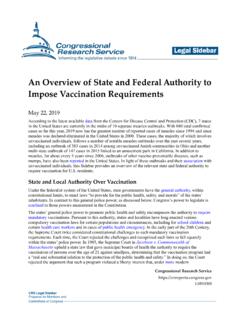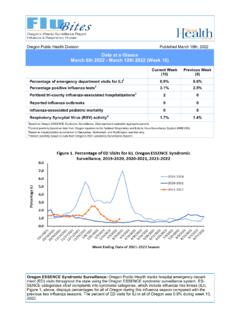Transcription of Cytotoxic T lymphocytes and natural ... - Columbia University
1 Cytotoxic T lymphocytes and natural killer cellsMargrit WiesendangerDivision of General Medicine, CUMCS eptember 16, 2009 Killer cells: CD8+T cells (adaptive) vs. natural killer (innate)Shared purpose:protect the host from viral, bacterial and parasitic infectionrecognize and destroy malignant cellsShared mechanismsof cytotoxicity and similar cytokine secretion profilesDistinct modes of target recognitionCytotoxic T lymphocytes Express CD8 (potentiates interaction with class I MHC molecule) Each T cell expresses a unique receptor, within a highly diverse repertoire generated by V(D)J recombination Scan MHC class I-peptide complexes, searching for pathogen or tumor-encoded antigens Preactivation and differentiation requiredNatural killer cells Invariant activating and inhibitory receptors Recognize missing self.
2 The absence of class I MHC on the cell surface triggers NK attack (viral or tumor strategy to evade immune surveillance by CD8+ T cells) No preactivation required, but significantly potentiated by cytokinesClinical relevance of Cytotoxic cellsToo Hot Autoimmune diseases: seronegativespondyloarthropathies, type I diabetes Hypersensitivity reactions Graft versus host disease Transplant rejectionToo Cold Immunodeficiency syndromes with decreased NK function: Chediak-Hidashisyndrome (CHS1 gene) Griscelli syndrome (Rab27a gene) Hermansky-Pudlaksyndrome (HPS1 gene) Familial HemophagocyticLymphohistiocytosis: (perforin gene defect)Just Right Host defense against: Viruses (HSV, EBV, CMV) Bacteria (Listeriamonocytogenes) Parasites (Plasmodium falciparum and Toxoplasma gondii) Primary and metastatictumors Graft versus leukemia effect NK cells in placenta: vascularization and inhibition of fetal rejectionExamples are provided for illustrative purposes: do not memorize!
3 Cytotoxic effector cells: armed and very dangerousImmune modulation: Production of inflammatory cytokines: interferon- tumor necrosis factor (TNF) Chemokine secretion: CCL3 (MIP1 ) CCL4 (MIP1 ) CCL5 (RANTES) Immunomodulatory cytokines: Interleukin-10 Granulocyte and MonocyteColony Stimulating Factor (GM-CSF)Cytotoxicity: Granzyme/perforin pathway Death receptor pathway: Fas/Fas ligand TNF-Related Apoptosis-Inducing Ligand (TRAIL) Cytotoxic T lymphocyte (CTL)-induced cell killing: a form of assisted suicide in which the target cell s endogenous apoptosis program is activatedStephen Nutt, Sebastian Carotta, Axel KalliesClinical Immunology: Principles and Practice, 3rd ed., Elsevier,ch. 18, p.
4 272 (2008)Perforin: disrupts cell membraneGranzyme A: cleaves nuclear proteins and facilitates double-stranded DNA breaksGranzyme B: activates the pro-apoptotic molecule BIDC ytotoxic T lymphocyte (CTL)-induced cell killing: Fas/FasLigand and TRAIL/TRAIL receptorsThomas Brunner lab website, Institute of Pathology, University of Bern, CHFas expressed on target cell: enables killing via Fas/FasL pathwayFas expressed activated T cell: provides mechanism for downregulating the immune response by T cell fratricide (activation-induced cell death, AICD)TRAIL (TNF-related apoptosis inducing ligand) expressed on activated T cell:enables killing (apoptosis) via signaling through the TRAIL receptor expressed by the target cell -- tumor cells may be particularly sensitive to this death pathwayTRAIL-RTRAILHow T cells become activated: life cycle of the dendritic cellJos A.
5 Villadangos, Louise J. YoungClinical Immunology: Principles and Practice, 3rd ed., Elsevier,ch. 7 (2008)How T cells become activated:Cellular interactions during an immune response in the lymph nodeStephen Nutt, Sebastian Carotta, Axel KalliesClinical Immunology: Principles and Practice, 3rd ed., Elsevier,ch. 18 (2008)IL-12, CCL3, CCL4 Antigenpresentation007: license to killIn order to be able to efficiently prime na ve CD8+ T cells, dendritic cells must first be licensed William Heath, Francis CarboneNature Reviews in Immunology 1: 126 (2001)CD4+ T cell help: licensing via CD40/CD40 LVirulent pathogen: licensing via Toll-like receptors (TLR)No license -> no primingGeneration of memory CTL: CD8+ T cells need help to rememberCD4+ T cell help: directly or indirectly produces cytokines that promote the survival, proliferation and programming of the memory T cell-deficient mice.
6 A model for the study of helpless CD8+ T cells, which resemble CTL in chronic infections in which pathogens are not cleared despite a robust CTL response. Two molecules have been found to mediate the defects in helpless CTL responses:1. Re-stimulation of helpless CTL leads to an abortive response due to AICD that is mediated by PD-1 (programmed death 1), an inhibitory member of the TNFR family,is expressed on both helpless CTL and on CTL cells during chronic infections. Blocking the interaction of PD-1 with its ligands greatly enhances the numbers and functions of the impaired Nutt, Sebastian Carotta, Axel KalliesClinical Immunology: Principles and Practice, 3rd ed., Elsevier,ch. 18 (2008)A T cell challenge: recognizing virus-infected cells when MHC class I is downregulated by virusMHC class I antigen presentation: learning from viral evasion strategiesTed H.
7 Hansen & Marlene BouvierNature Reviews Immunology 9, 503-513 (July 2009) Cross-presentation : a hybrid pathway that permits presentation of exogenous antigens in the context of MHC class IWilliam Heath, Francis CarboneNature Reviews in Immunology 1: 126 (2001)Direct presentation Cross-presentation class IIclass IWhat if a virus directly infects and shuts down the antigen-presenting cell?Cross-presentation pathways can take over William Heath, Francis CarboneNature Reviews in Immunology 1: 126 (2001)Detection and analysis of CTL functionStephen Nutt, Sebastian Carotta, Axel KalliesClinical Immunology: Principles and Practice, 3rd ed., Elsevier,ch. 18 (2008)Peptide-MHC class I complexBiotin-avidinNatural Killer CellsStephen Nutt, Sebastian Carotta, Axel KalliesClinical Immunology: Principles and Practice, 3rd ed.
8 , Elsevier,ch. 18, p. 277 (2008) Surveillance function: NK cells are found in: Peripheral blood Secondary lymphoid organs: bone marrow, spleen, activated lymph nodes Peripheral tissue: liver, lung and the decidual lining of the uterus Key cytokines: Interleukin-15: required for NK cell development IL-12, IL-18: promote activation, cytotoxicity, IFN- production Key surface markers: CD16 (Fc RIII), binds IgG and promotes the antibody-dependent cytotoxicity(ADCC) of NK cells CD56 (adhesion molecule), Killer cell Immunoglobulin-like Receptor (KIR): recognize MHC class I molecules (HLA-A, B, C). A specific allele (KIR3DS1) can recognize HIV peptide in HLA-Bw4 and is associated with slow progression to subsets of human natural killer cellsStephen Nutt, Sebastian Carotta, Axel KalliesClinical Immunology: Principles and Practice, 3rd ed.
9 , Elsevier,ch. 18, p. 272 (2008)CD56dimCD16brightKIR+predominant NK cells in peripheral blood, highly cytotoxicCD56brightCD16dimKIR+/-predomin ant NK population in secondary lymphoid organs, highly proliferative, greater cytokine productionNatural Killer cells vs. Cytotoxic T cells: target recognitionStephen Nutt, Sebastian Carotta, Axel KalliesClinical Immunology: Principles and Practice, 3rd ed., Elsevier,ch. 18, p. 272 (2008)NK cellCytotoxic T cellReceptor typeNK receptor (numerous activating or inhibitory)T cell receptorLigand typeClass I MHC, MICA/B, immune complexes, class I complexAbsence of class I MHC results cytotoxicity( missing self )Lack of recognitionPresence of class I MHC results signal to NK cellTCR engagementNK cell receptorsStephen Nutt, Sebastian Carotta, Axel KalliesClinical Immunology: Principles and Practice, 3rd ed.
10 , Elsevier,ch. 18, p. 272 (2008)Inhibitory receptors: Recognize mostly MHC class I ligands with high affinity Signal via ImmunoTyrosineInhibitory Motifs (ITIM) Recruit phosphatases (SHP and SHIP) to prevent a cytotoxicresponse Required for NK cell licensingActivating receptors: Ligands include viral molecules and stress induced proteins Do not bind MHC class I molecules with high affinity Signal via ImmunoTyrosineActivating Motifs (ITAM) Use several signaling adaptors, including DAP12 Note: most NK cell receptors can also be expressed by some T cells after activationSpecific NK cell functions (I)Stephen Nutt, Sebastian Carotta, Axel KalliesClinical Immunology: Principles and Practice, 3rd ed., Elsevier,ch. 18, p.
















